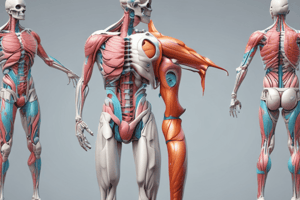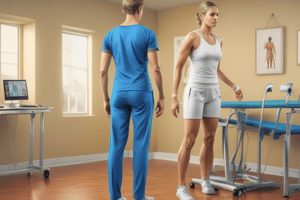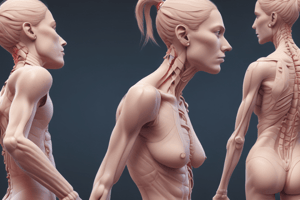Podcast
Questions and Answers
What is the purpose of comparing observations with the traditional image of good postural alignment?
What is the purpose of comparing observations with the traditional image of good postural alignment?
- To discourage the use of traditional image in posture assessment
- To detect abnormalities in posture alignment (correct)
- To promote the traditional image as the ideal posture
- To justify the use of traditional image in posture assessment
Which method can be used for visual observation in posture assessment?
Which method can be used for visual observation in posture assessment?
- Sight and Plumb line (correct)
- Moire topography
- MRI scan
- Plain X-ray
What is the definition of posture?
What is the definition of posture?
- The relationship between different parts of the body to maintain a bad alignment
- The arrangement of body parts to maintain a bad alignment
- The arrangement of body parts to maintain a good alignment (correct)
- The relationship between different parts of the body to maintain an upright position
Which test can be used for diagnosing scoliosis?
Which test can be used for diagnosing scoliosis?
What should be the level of shoulder height for good posture?
What should be the level of shoulder height for good posture?
What is the role of the plumb line in posture assessment?
What is the role of the plumb line in posture assessment?
What should be the position of the head according to the Plumb Line?
What should be the position of the head according to the Plumb Line?
What indicates correct shoulder position as per the Plumb Line?
What indicates correct shoulder position as per the Plumb Line?
In a lateral postural assessment, the Plumb Line is taken through which part of the body?
In a lateral postural assessment, the Plumb Line is taken through which part of the body?
What should be the position of the lumbar spine in terms of curvature?
What should be the position of the lumbar spine in terms of curvature?
How should the space between the client's arm and body be in a correct upper limb position?
How should the space between the client's arm and body be in a correct upper limb position?
What indicates correct pelvic position as per the Plumb Line?
What indicates correct pelvic position as per the Plumb Line?
What is the correct position of the knees and legs as per the Plumb Line?
What is the correct position of the knees and legs as per the Plumb Line?
What should be the level of lateral malleoli according to the Plumb Line?
What should be the level of lateral malleoli according to the Plumb Line?
What is a correct representation of upper limb position?
What is a correct representation of upper limb position?
Detecting abnormalities is not a part of making assessments for upper and lower body posture from anterior view.
Detecting abnormalities is not a part of making assessments for upper and lower body posture from anterior view.
The formetric topography method is not used for the diagnosis of scoliosis.
The formetric topography method is not used for the diagnosis of scoliosis.
Visual observation method by sight is the only method used for postural assessment.
Visual observation method by sight is the only method used for postural assessment.
The ideal posture of the posterior view includes the head facing forwards with rotation and lateral flexion.
The ideal posture of the posterior view includes the head facing forwards with rotation and lateral flexion.
The Plumb Line is not used to assess the level of the shoulders.
The Plumb Line is not used to assess the level of the shoulders.
The traditional images of the ideal posture include a lateral image showing the ear level, head and neck at different levels.
The traditional images of the ideal posture include a lateral image showing the ear level, head and neck at different levels.
The space formed between the client’s arm and body should be the same on both sides for correct upper limb position.
The space formed between the client’s arm and body should be the same on both sides for correct upper limb position.
The scapulae should lie flat against the rib cage with no anterior tilting.
The scapulae should lie flat against the rib cage with no anterior tilting.
The lumbar spine should have no curvature to the right or left for a good posture alignment.
The lumbar spine should have no curvature to the right or left for a good posture alignment.
The knees should be straight and equidistant from the plumb line with no genu varum or genu valgum for correct leg position.
The knees should be straight and equidistant from the plumb line with no genu varum or genu valgum for correct leg position.
The lateral malleoli should be level according to the Plumb Line.
The lateral malleoli should be level according to the Plumb Line.
The head should appear positioned over the thorax—neither pushed forwards with chin out nor pulled back, as per the Plumb Line.
The head should appear positioned over the thorax—neither pushed forwards with chin out nor pulled back, as per the Plumb Line.
The greater trochanters of the femurs should be level according to the Plumb Line.
The greater trochanters of the femurs should be level according to the Plumb Line.
The buttock creases should be level and equal as per the Plumb Line.
The buttock creases should be level and equal as per the Plumb Line.
The scapulae should be equidistant from the spine according to the Plumb Line.
The scapulae should be equidistant from the spine according to the Plumb Line.
The calcaneus should be vertical according to the Plumb Line.
The calcaneus should be vertical according to the Plumb Line.
Flashcards are hidden until you start studying
Study Notes
Posture Assessment
- Comparing observations with the traditional image of good postural alignment helps identify deviations from the ideal posture.
Definition of Posture
- Posture is the position in which the body is held while standing, sitting, or lying.
Methods of Posture Assessment
- Visual observation is a method used for posture assessment.
- Formetric topography is a method used for the diagnosis of scoliosis.
Characteristics of Good Posture
Plumb Line
- The Plumb Line is used to assess posture alignment.
- The head should appear positioned over the thorax, neither pushed forward with chin out nor pulled back.
- The shoulders should be level.
- The scapulae should lie flat against the rib cage with no anterior tilting and equidistant from the spine.
- The space formed between the client's arm and body should be the same on both sides.
- The lumbar spine should have a normal curvature.
- The knees should be straight and equidistant from the plumb line with no genu varum or genu valgum.
- The lateral malleoli should be level.
- The greater trochanters of the femurs should be level.
- The buttock creases should be level and equal.
- The calcaneus should be vertical.
Lateral Postural Assessment
- The Plumb Line is taken through the ear, shoulder, buttock, knee, and lateral malleolus.
Scoliosis Diagnosis
- Formetric topography can be used to diagnose scoliosis.
Studying That Suits You
Use AI to generate personalized quizzes and flashcards to suit your learning preferences.




